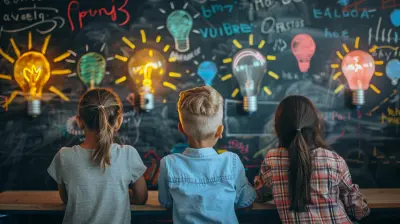23 November 2025
Let’s be honest — how many times have you asked yourself, “When am I ever going to use this in real life?” while stuck in a classroom? Students have been echoing that same question for decades, and for good reason. It's one thing to read about concepts in textbooks or listen to a lecture. It's a whole different ball game to actually apply those lessons in real-world situations.
That’s where lesson plans that bridge the gap between theory and practice come in. Imagine turning a classroom into a mini-lab, a newsroom, or even a startup. Sounds exciting, right? That’s because it is! In this article, we’re going to dive deep into how educators can design lesson plans that make learning relevant, practical, and downright fun.
Why the Gap Between Theory and Practice Exists
Before we roll up our sleeves and create action-packed lesson plans, let’s look at why this gap exists in the first place.The Ivory Tower Problem
Education systems often focus more on theoretical understanding than practical application. Students cram for tests, memorize formulas, and write essays... but they rarely get asked to do something with that knowledge.Lack of Real-World Context
Another culprit? Content often lacks context. Sure, the Pythagorean theorem is cool (sorta), but unless you're an architect or engineer, most folks struggle to see where it fits in their lives.One-size-fits-all Lessons
Lastly, most traditional lesson plans are rigid. They cater to the average student and ignore diverse learning styles. Not everyone learns best by sitting still and listening.So, how do we fix that? Easy. We build lesson plans that marry theory with practice — hands-on, minds-on.
Key Elements of a Lesson Plan that Bridges the Gap
Creating this kind of lesson plan isn’t rocket science, but it does require intention. Here’s what you need to include:1. Clear Learning Objectives (But Keep 'Em Real)
Start with solid, measurable goals, but make them realistic and rooted in real-world application. Instead of saying “Students will understand supply and demand”, try “Students will create a small business plan that reflects supply and demand principles.”2. Scenario-Based Learning
Real-world scenarios = lightbulb moments. Try anchoring your lesson in a situation that students can imagine themselves in. Want to teach budgeting? Have them plan a vacation with a limited budget. Teaching environmental science? Make them consultants solving pollution in a local river.3. Project-Based Assessment
Ditch the multiple-choice tests and give students projects. This lets them show not just what they know — but what they can actually do.4. Collaboration & Communication
The workplace isn’t a solo gig, so your classroom shouldn’t be either. Group work encourages communication, creativity, and problem-solving — key life skills students need long after they toss their graduation cap.5. Feedback Loops
Give students time to reflect and revise. Practice doesn’t make perfect — feedback does. Make your classroom a safe space to fail, learn, and try again.
Sample Lesson Plan Templates That Blend Theory and Practice
Let’s break it down even further. Here are a few detailed ideas across different subjects that pack a punch.💡 Science: Save the Planet Simulation
Topic: Environmental SustainabilityObjective: Apply ecological principles to address real-world environmental issues.
Activity: Divide students into teams as 'green consultants' hired to clean up a fictional town’s river. They’ll research local pollution sources, create a cleanup plan, and pitch it to a mock town council (aka the class).
Why It Works: It connects textbook ecology to community action and gives students a sense of purpose.
📊 Math: The Budget Boss Project
Topic: Financial Literacy & AlgebraObjective: Apply mathematical reasoning to a real-life budgeting problem.
Activity: Students plan a dream vacation within a set budget. They’ll compare prices, create spreadsheets, calculate costs, and adjust based on expenses.
Why It Works: Budgeting isn’t just numbers — it’s life. This activity is math with meaning.
✍️ Language Arts: Real-World Journalism
Topic: Writing & CommunicationObjective: Use persuasive writing techniques in real-world formats.
Activity: Students pick a local issue, conduct interviews, gather research, and write a persuasive editorial or news article. Bonus: submit it to the school paper or a community blog.
Why It Works: It combines reading, writing, critical thinking — and gives students a voice.
🌍 Social Studies: Policy Debate Challenge
Topic: Civics & GovernmentObjective: Analyze current policies and propose innovative solutions.
Activity: Teams choose a controversial policy (education, public health, the environment), research it, and participate in structured debates.
Why It Works: Teaches research, argument construction, and civic engagement — forget dry textbook readings.
💻 Computer Science: Build That App!
Topic: Programming FundamentalsObjective: Design and code a basic app solving a real problem.
Activity: Students brainstorm a problem in their school or community and create an app prototype that solves it. They’ll plan the user interface, code the back-end, and present a demo.
Why It Works: It's coding with a cause — and that motivates students in a big way.
How to Make These Lesson Plans Stick
Even the best lesson plan can flop if it’s not built on a solid foundation. Here’s how to make sure yours land well:Know Your Students
Who are they? What excites them? What are their dreams and struggles? The more your lessons connect to their world, the more they'll engage.Use Tech (But Wisely)
Tech can be your best friend — or a major distraction. Use apps, videos, and online tools that enhance, not replace, good teaching.Be Flexible
Real-world problems don’t come with tidy answers — and neither do great projects. Be ready to adjust the timeline, shift the focus, or let students take the wheel.Celebrate Process Over Product
Sure, the final work matters. But the process of learning, trying, and discovering is where the real magic happens. Celebrate the journey, not just the grade.Benefits of Merging Theory and Practice in the Classroom
So, why go through all this effort? Because the payoff is HUGE.🚀 Engagement Shoots Up
Students are naturally more interested when they see the relevance. They’re not just studying for a test — they’re solving real problems.🎯 Skills Get Sharper
From teamwork to time management, communication to creativity — practical projects help students fine-tune essential life and career skills.💡 Learning Feels Meaningful
When students see the real-world value of what they’re learning, they’re more likely to retain and apply it far beyond the classroom.Final Thoughts: Let’s Make Learning Matter
We owe it to our students to make education something they can use. Books and lectures are still important — they’re the foundation. But without application, they’re like building a ship and never taking it out to sea.Imagine a classroom where students don’t just ask “Why do I need to learn this?” — they already know. Because they’re living the lesson.
It’s time to bridge the gap between theory and practice. You in?


